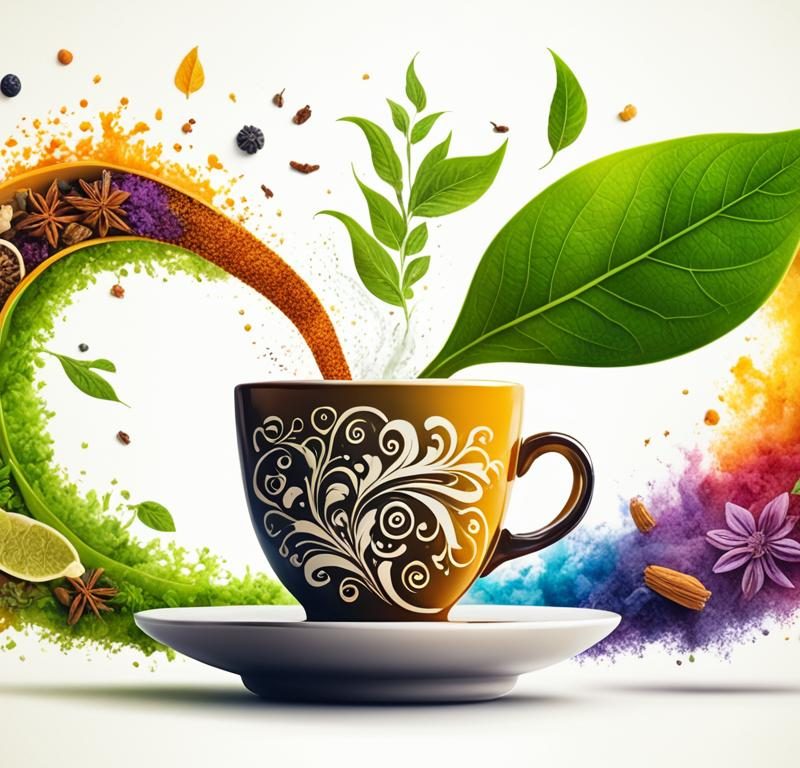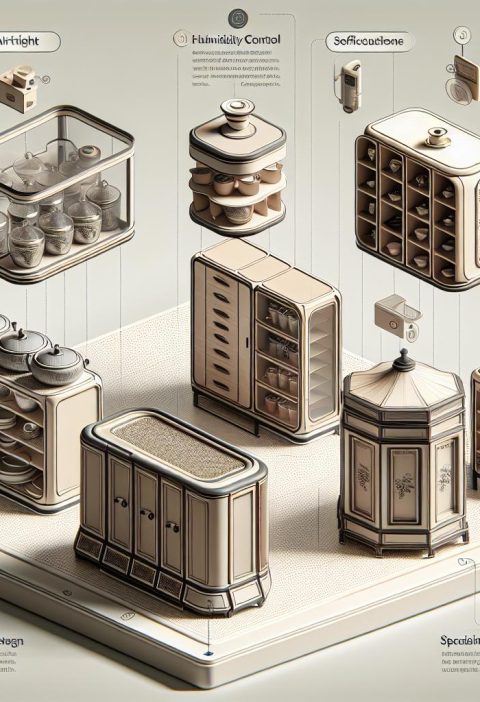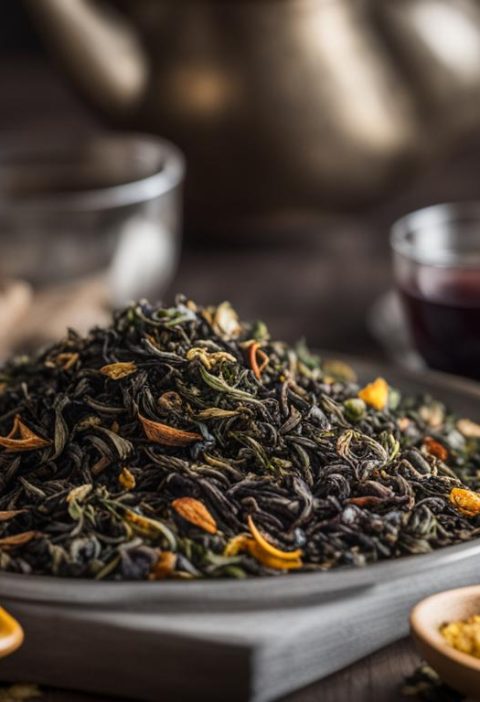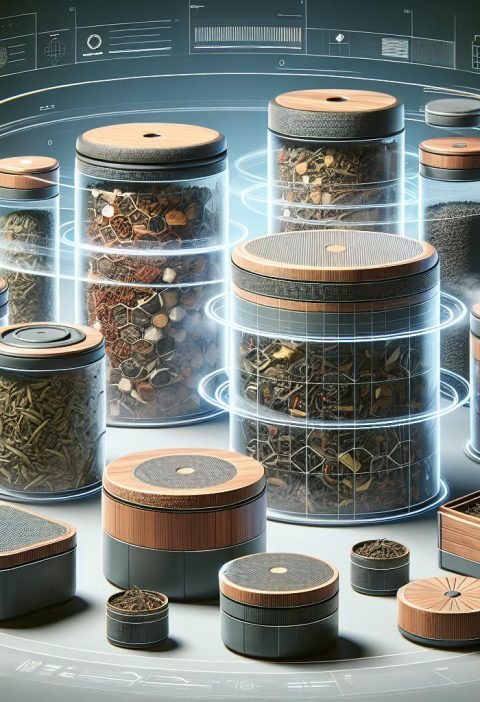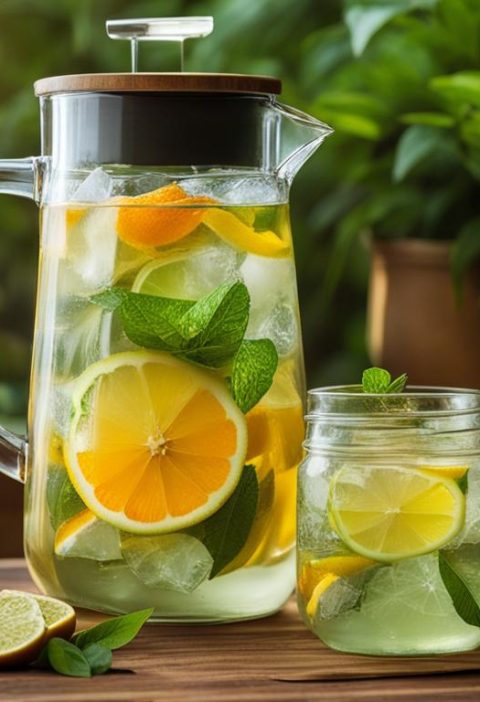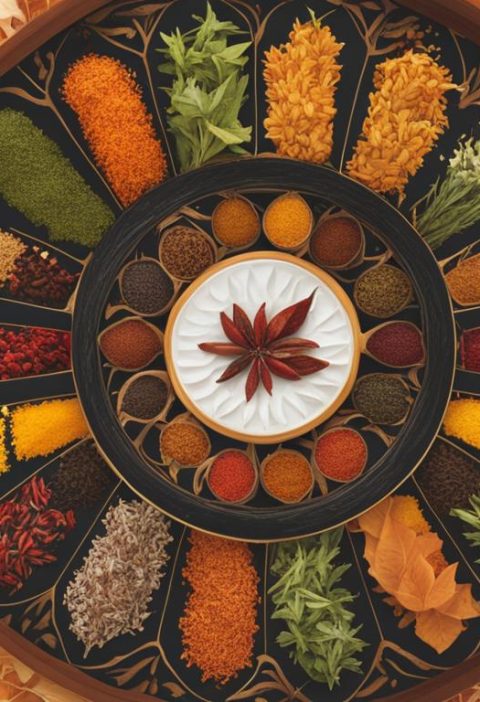Tea is a beloved beverage enjoyed by people all over the world. The brewing process plays a crucial role in the extraction of aroma and flavor from tea leaves, ultimately impacting the overall tea-drinking experience. To maximize the aromatic potential of tea, it is important to understand the various aroma extraction methods in tea brewing and implement effective techniques. In this article, we will explore the best practices for extracting aroma in tea, techniques for enhancing aroma, and advanced aroma extraction methods for tea connoisseurs. Whether you are a tea enthusiast or a professional in the tea industry, these insights will help you improve the aroma extraction in your tea brewing.
Key Takeaways:
- Understanding the importance of aroma in tea enhances the overall tea-drinking experience.
- Choosing high-quality tea leaves is crucial for maximizing aroma extraction.
- Water temperature plays a significant role in extracting aroma from tea leaves.
- Traditional steeping, Gongfu brewing, scented tea brewing, cold brewing, and the use of tea infusers and strainers are different methods for aroma extraction.
- Experimenting with different aroma extraction techniques can elevate your tea brewing skills.
Understanding the Importance of Aroma in Tea
The aroma of tea is an integral aspect that significantly impacts the overall taste experience. When hot water is poured over tea leaves during the brewing process, volatile compounds are released, creating a delightful and enticing scent. This aroma enhances the sensory experience and deepens our appreciation for the diverse varieties of tea and their unique nuances.
Tea aroma compounds are responsible for the captivating fragrances that differentiate one tea from another. These compounds come from various chemical families, including aldehydes, esters, and terpenes. The combination of these volatile substances produces the characteristic aromas of different tea types, such as floral, fruity, herbal, or earthy notes. The intricate interplay of these compounds contributes to the rich complexity and depth of tea flavors.
The olfactory aspect of tea drinking is essential for a complete sensory experience. In addition to taste and visual appearance, the aroma plays a vital role in perceiving the quality and authenticity of tea. When we carefully inhale the aroma of a freshly brewed cup of tea, our olfactory receptors capture the delicate nuances and subtle fragrances, heightening our anticipation for the first sip.
Moreover, the impact of aroma on tea quality extends beyond the sensory experience. The presence of distinct and well-balanced aromas indicates the overall quality and freshness of the tea. A robust and delightful aroma often corresponds to tea leaves that have been carefully processed and stored under optimal conditions. The absence or off-notes in aroma may indicate poor quality or improper storage, affecting the overall tea experience.
The Sensory Experience of Tea Aroma
To fully appreciate the sensory experience of tea aroma, it is crucial to engage all our senses. When we bring the teacup close to our lips, the fragrant steam caresses our face, heightening our anticipation. As we take our first sip, the aroma envelops our nasal passages, intensifying the flavors on our palate. Each subsequent sip reveals new layers of aroma and taste, creating a multi-dimensional and immersive tea-drinking experience.
Since aroma is a key component of tea’s sensory experience, tea connoisseurs often employ a technique known as “cupping” to evaluate and appreciate different tea varieties. Cupping involves deeply inhaling the aroma released from the tea leaves before and after the infusion, noting the nuances and intensity. This process enables us to discern the quality, flavors, and complexities that the aroma imparts to the overall tea profile.
| Aroma Description | Tea Variety |
|---|---|
| Fruity and Citrusy | Green and White Teas |
| Floral and Perfumy | Oolong and Scented Teas |
| Malts and Earthy | Black and Pu-erh Teas |
Understanding and appreciating the importance of aroma in tea enriches our tea-drinking experience, allowing us to perceive the intricate flavors and nuances that each cup offers. By consciously engaging our senses and exploring the different aromatic profiles of tea, we can elevate the enjoyment of this timeless beverage.
Overview of Aroma Extraction Methods in Tea Brewing
There are several techniques available for extracting and enhancing the aroma in tea. Each method offers a unique approach to maximizing aroma extraction and provides a distinct sensory experience for tea connoisseurs. In this section, we will explore traditional steeping, Gongfu brewing, scented tea brewing, cold brewing, and the use of tea infusers and strainers.
Traditional Steeping
Traditional steeping is the most common and accessible method for brewing tea. It involves pouring hot water over tea leaves and allowing them to infuse for a specific period. The aroma is extracted as the volatile compounds in the leaves are released during the steeping process. Traditional steeping allows the full flavors and aromas of the tea to develop and provides a well-rounded and balanced cup.
Gongfu Brewing
Gongfu brewing is a traditional Chinese tea brewing technique that is known for maximizing aroma extraction. It involves multiple short infusions of tea leaves using a small teapot or gaiwan. Gongfu brewing focuses on unlocking the complex flavors and aromas of the tea by using higher leaf-to-water ratios and shorter steeping times. This method allows the tea connoisseur to fully explore the intricate nuances of different tea varieties.
Scented Tea Brewing
Scented tea brewing is a method used for teas that have been infused with floral or fruity aromas. Examples include Jasmine tea and Rose tea. In scented tea brewing, the tea leaves absorb the fragrance from the added flowers. The aroma is released during the brewing process and enriches the tea’s taste and olfactory experience. Scented tea brewing requires careful attention to water temperature and steeping times to achieve the desired aroma intensity.
Cold Brewing
Cold brewing is a technique that involves steeping tea leaves in cold or room temperature water over an extended period. This slow extraction process results in a smoother and less astringent tea with delicate aromatic notes. Cold brewing is particularly suited for more delicate tea varieties, such as green and white teas. It is a refreshing way to enjoy tea and provides a unique flavor profile that highlights the tea’s natural sweetness and aroma.
Using Tea Infusers and Strainers
Tea infusers and strainers are practical tools for brewing loose-leaf tea and enhancing aroma extraction. They allow the tea leaves to expand fully and release their aromatic compounds during steeping. Tea infusers come in various shapes and sizes, from mesh balls to mesh baskets and tea eggs. Strainers, on the other hand, are used to filter out loose tea leaves when pouring the brewed tea into cups. Both of these tools make the brewing process convenient and ensure a flavorful and aromatic cup of tea.
Table 3: Comparison of Aroma Extraction Methods
| Extraction Method | Aroma Extraction | Sensory Experience |
|---|---|---|
| Traditional Steeping | Gradual extraction of aroma compounds | Well-rounded and balanced flavors |
| Gongfu Brewing | Maximized aroma extraction | Exploration of nuanced flavors and aromas |
| Scented Tea Brewing | Infused floral or fruity aromas | Enriched taste and olfactory experience |
| Cold Brewing | Subtle and delicate aromatic notes | Smooth and refreshing tea |
| Tea Infusers and Strainers | Full extraction of aroma compounds | Convenient brewing with enhanced flavor and aroma |
Choosing the Right Tea Leaves for Aroma Extraction
The quality of tea leaves plays a vital role in the extraction of aroma in brewed tea. By selecting high-quality tea leaves, we can enhance the intensity and richness of aromas, ultimately elevating the overall tea drinking experience.
When choosing tea leaves for aroma extraction, it is recommended to opt for loose-leaf tea instead of tea bags. Loose-leaf tea allows for a more efficient release of aroma compounds, resulting in a more pronounced fragrance. Moreover, selecting whole and intact tea leaves ensures that the essential oils and volatile compounds are preserved, contributing to a superior aroma.
The type of tea leaves also influences the specific aroma profiles. Different varieties of tea, such as green, black, or oolong, possess distinct aromatic characteristics. Green tea, known for its grassy and vegetal notes, offers a fresh and delicate aroma. Black tea, on the other hand, exhibits a robust and malty fragrance. Oolong tea strikes a balance between the earthiness of black tea and the vibrancy of green tea, delivering a nuanced aroma.
To ensure the freshest and most vibrant flavors, it is essential to choose tea leaves that have been recently harvested. Freshness plays a significant role in preserving the delicate aromas of the tea leaves. Selecting tea leaves that are as close to the harvest date as possible guarantees an optimal aroma extraction and a delightful tea experience.
Comparison of Aroma Intensity in Different Tea Varieties
| Tea Variety | Aroma Intensity |
|---|---|
| Green Tea | Medium |
| Black Tea | High |
| Oolong Tea | Medium-High |
As seen in the table above, black tea generally has the highest aroma intensity, followed by oolong tea. Green tea, on the other hand, exhibits a slightly milder aroma. These variations in aroma intensity are shaped by factors such as tea processing methods, oxidation levels, and the presence of specific volatile compounds. By understanding these differences, tea enthusiasts can choose the tea leaves that align with their aromatic preferences.
To summarize, selecting high-quality tea leaves is crucial for extracting the desired aromas in brewed tea. Opting for loose-leaf tea, choosing intact leaves, considering the type of tea leaves, and ensuring freshness are all essential factors in enhancing aroma extraction. By making thoughtful choices, we can elevate the sensory experience and savor the delightful aromas of our favorite teas.
Understanding the Impact of Water Temperature on Aroma Extraction
Water temperature is a crucial factor in extracting the aromatic compounds from tea leaves. Different types of tea require specific water temperatures to maximize their aromatic potential and enhance the overall tea drinking experience. Let’s take a closer look at the optimal brewing temperatures for different tea varieties and the impact of water temperature on tea flavor.
Optimal Brewing Temperature for Different Tea Types
To achieve the best aroma extraction, it’s important to brew each type of tea at the appropriate temperature:
| Tea Type | Optimal Brewing Temperature |
|---|---|
| Green Tea | 160°F – 180°F |
| Black Tea | Around 200°F |
| Oolong Tea | 190°F – 200°F |
By following these temperature guidelines, you can ensure that the aroma compounds in tea leaves are efficiently extracted and contribute to a flavorful and aromatic cup of tea.
The Impact of Water Temperature on Tea Flavor
The water temperature used for tea brewing directly affects the flavor profile of the final cup. Higher temperatures tend to extract more tannins and bitterness, while lower temperatures result in a milder and smoother taste. When it comes to aroma extraction, the right water temperature unlocks the full potential of the tea’s aromatic properties.
For example, brewing green tea at too high a temperature can result in a bitter and astringent taste, overpowering the delicate flavors and aromas. On the other hand, brewing black tea at lower temperatures may yield a weaker, less flavorful cup.
To fully appreciate the nuances of each tea and enjoy its distinctive aroma, it’s essential to adhere to the recommended brewing temperatures.
Now that we understand the importance of water temperature in aroma extraction, let’s explore specific brewing techniques that can further enhance the tea drinking experience.
Traditional Steeping Method for Aroma Extraction
The traditional steeping method is a popular and accessible technique for brewing tea. By following a step-by-step guide, you can ensure a flavorful and aromatic cup of tea. Here’s how:
- Boil water to the appropriate temperature: Different types of tea require specific water temperatures to unlock their flavors and aromas. Green teas generally need water heated to around 160°F to 180°F, while black teas benefit from hotter water at approximately 200°F. Refer to the packaging or consult a tea brewing guide for the recommended temperature.
- Measure the tea leaves: Use a tea measuring spoon or scale to determine the desired amount of tea leaves. The ideal ratio is typically 1 teaspoon of tea leaves per 8 ounces of water. Adjust the quantity based on personal preference.
- Steeping time: The duration that tea leaves steep in hot water greatly affects the flavor and aroma profile of the brewed tea. Follow the brewing time guidelines provided with the tea or experiment to find the perfect balance. For example, delicate green teas may require a shorter steeping time of 2 to 3 minutes, while robust black teas can be steeped for 3 to 5 minutes.
- Enhancing aroma during steeping: To further enhance the aroma of your tea, consider these tips:
- Pre-warm your teapot before steeping: Pour hot water into the teapot and let it sit for a minute before discarding the water. This helps maintain the desired brewing temperature and ensures a flavorful infusion.
- Adjust tea-to-water ratio: Experiment with slightly increasing or decreasing the amount of tea leaves used to find the perfect balance of flavor and aroma.
Incorporating these steps into your tea brewing routine will help you achieve a delightful cup of tea with rich aroma and satisfying flavors.
Gongfu Brewing Technique for Aroma Extraction
Gongfu brewing is a traditional Chinese tea brewing technique known for its ability to extract maximum aroma from tea leaves. This method involves multiple infusions of tea leaves using a small teapot or gaiwan, allowing tea enthusiasts to unlock the full flavor potential of their tea.
Key steps in Gongfu brewing include:
- Tea Leaf Rinsing: Before the brewing process begins, rinse the tea leaves with hot water for a few seconds. This step helps to awaken the leaves and remove any impurities.
- Short Steeping Times: Gongfu brewing involves short and rapid steeping times, typically ranging from a few seconds to a minute. These brief infusions extract the aroma and flavor compounds without over-extracting bitterness from the leaves.
- Multiple Infusions: Unlike other brewing methods, Gongfu brewing allows for multiple infusions of the same tea leaves. Each infusion brings out different nuances of flavor and aroma, making each cup a unique experience.
- Intensity and Aroma: The careful attention to aroma and flavor profiles in Gongfu brewing is designed to create a highly aromatic and immersive tea experience. By focusing on extracting the delicate fragrance of the tea leaves, Gongfu brewing showcases the true essence of the tea.
- Specialized Equipment: Gongfu brewing requires specialized equipment, including a small teapot or gaiwan, tea cups, a tea tray, and a tea towel. These tools are designed to enhance the brewing process and ensure optimum aroma extraction.
Gongfu brewing offers tea enthusiasts the opportunity to fully appreciate the complex aromas and flavors of their favorite teas. The technique’s meticulous approach to brewing and its emphasis on aroma extraction make it a popular choice among tea connoisseurs worldwide.
Scented Tea Brewing Method for Aroma Extraction
Scented teas, such as Jasmine tea and Rose tea, are renowned for their delightful floral and fruity aromas, which add an extra layer of fragrance and complexity to the tea-drinking experience. To fully appreciate the captivating aromas present in scented teas, it is important to understand the brewing techniques that maximize aroma extraction. Additionally, knowing the recommended steeping times and water temperatures ensures that you can enjoy scented teas at their aromatic best.
When brewing scented teas, it is crucial to use water that is the right temperature. This can vary depending on the specific type of scented tea you are preparing. For example, Jasmine tea is best brewed with water temperatures between 175°F and 185°F (79°C to 85°C), while Rose tea benefits from slightly cooler water between 165°F and 175°F (74°C to 79°C). The appropriate water temperature helps extract the aroma compounds effectively, resulting in a more pronounced fragrance.
Another factor to consider when brewing scented teas is the recommended steeping time. Steeping times can vary depending on the desired strength of the aroma and the specific tea variety. Generally, Jasmine tea is steeped for around 2 to 4 minutes, while Rose tea can be steeped for 3 to 5 minutes. Adjusting the steeping time allows for a balance between aroma extraction and flavor development.
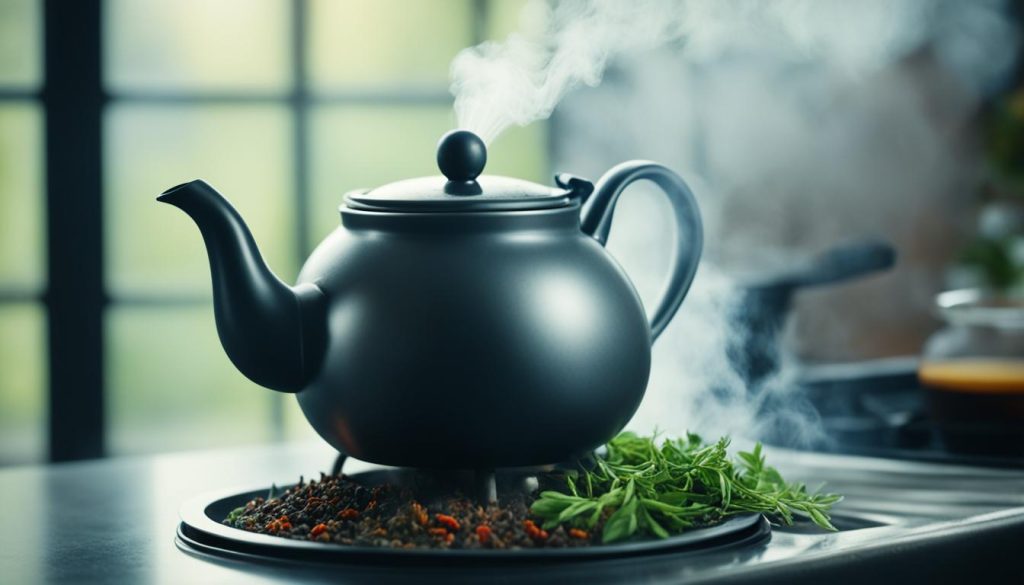
The specific aroma compounds found in scented teas contribute to their unique floral and fruity fragrances. For example, Jasmine tea is infused with jasmine flowers during its production, resulting in its distinctive floral aroma. Similarly, Rose tea incorporates dried rose petals, infusing the tea leaves with a delicate and fragrant floral essence. These aroma compounds create the captivating scents that make scented teas so enticing.
By following the recommended steeping times and using the appropriate water temperature, you can fully savor and enjoy the delightful floral and fruity aromas of scented teas. The precise brewing techniques help extract the aroma compounds, creating a sensory experience that is both captivating and satisfying.
Cold Brewing Technique for Aroma Extraction
Cold brewing is a popular method of steeping tea that involves using cold or room temperature water over an extended period. This technique offers a unique way to extract the aromas from tea leaves, resulting in a smoother and less astringent taste while preserving the delicate flavors.
To cold brew tea, follow this step-by-step guide:
- Select your favorite loose-leaf tea. Choose high-quality tea leaves for the best flavor and aroma extraction.
- Measure the desired amount of tea leaves. As a general rule, use 1 tablespoon of tea leaves per 8 ounces of water.
- Place the tea leaves in a glass pitcher or container.
- Add cold or room temperature water to the pitcher. The water-to-tea ratio can be adjusted according to your preference, but a common ratio is 1 part tea to 8 parts water.
- Stir gently to ensure the leaves are fully submerged in the water.
- Cover the pitcher or container and let it steep in the refrigerator for at least 4 hours, or overnight for a stronger flavor.
- Once the desired brewing time has passed, strain the tea leaves using a fine-mesh strainer or cheesecloth.
- Serve the cold-brewed tea over ice and enjoy!
Cold brewing offers several benefits for aroma extraction:
- Slow extraction of aromas: The extended steeping time allows for a gradual and thorough extraction of the tea’s aromatic compounds, resulting in a more robust flavor profile.
- Smooth and less astringent taste: Cold brewing reduces the release of tannins, which can contribute to bitterness and astringency. As a result, the brewed tea is smoother and more mellow on the palate.
- Preserves delicate aromas: The lower temperature and longer steeping time help retain the delicate floral, fruity, and herbal aromas of the tea leaves, creating a more aromatic and enjoyable tea-drinking experience.
Give cold brewing a try and discover a refreshing and flavorful way to enjoy your favorite teas!
Using Tea Infusers and Strainers for Aroma Extraction
Tea infusers and strainers are essential tools for brewing loose-leaf tea and maximizing aroma extraction. They allow for the delicate flavors and aromas of the tea leaves to infuse into the hot water, creating a rich and immersive tea experience. In this section, we will explore the different types of tea infusers and strainers available and provide tips for using them effectively.
Types of Tea Infusers
There are various types of tea infusers, each with its own unique features and benefits. Here are some popular options:
| Tea Infuser | Description | Image |
|---|---|---|
| Ball Infuser | This infuser features a small mesh ball that holds the tea leaves. It is convenient and easy to use, allowing for quick and efficient brewing. | |
| Basket Infuser | A basket infuser is larger in size and offers more space for the tea leaves to expand. It provides better water circulation, resulting in a more flavorful brew. | |
| Teapot Infuser | This infuser is designed to fit inside a teapot and allows for brewing a larger quantity of tea. It is perfect for sharing with friends and family. |
Tips for Using Tea Infusers and Strainers
To make the most out of your tea infusers and strainers, consider the following tips:
- Choose high-quality loose-leaf tea: Using loose-leaf tea instead of tea bags ensures that you have access to the full flavor and aroma of the tea leaves.
- Measure the right amount of tea: Follow the recommended tea-to-water ratio to achieve the desired strength of your brew.
- Preheat your teapot or cup: Pouring hot water into your teapot or cup before adding the tea leaves helps to maintain the optimal brewing temperature and enhances the aroma.
- Steep for the right amount of time: Different types of tea require different steeping times. Refer to the packaging or use a timer to achieve the optimal flavor.
- Experiment with different infusers: Try using different types of infusers to see which one works best for your personal preference and tea variety.
By using tea infusers and strainers and following these tips, you can elevate your loose-leaf tea brewing experience and enjoy the full aroma and flavor of your favorite teas.
Conclusion
In conclusion, aroma extraction is a fundamental element of tea brewing that significantly influences the overall tea drinking experience. By recognizing the significance of aroma, carefully selecting high-quality tea leaves, adjusting water temperature, and employing different brewing techniques, tea enthusiasts can unlock the full potential of tea’s aromatic properties. Whether through traditional steeping, Gongfu brewing, scented tea brewing, cold brewing, or the use of tea infusers and strainers, there are numerous methods available to enhance aroma extraction and create an immersive tea experience.
The aroma of tea plays a vital role in elevating the sensory pleasure derived from each sip. The different aroma compounds released during the brewing process contribute to the distinct flavors and nuances found in various tea varieties. Exploring the diverse aroma extraction methods allows tea connoisseurs to fully appreciate the intricate aromas and enhance their exploration of tea.
With a deeper understanding of aroma extraction techniques, tea lovers can adapt their brewing practices to suit their personal preferences and desired sensory experiences. Experimenting with different combinations of brewing methods, tea types, brewing times, and water temperatures allows for a customized approach to aroma extraction. Each cup of tea becomes an opportunity to delve into the captivating world of aromas and flavors, offering a truly immersive and indulgent tea drinking journey.
